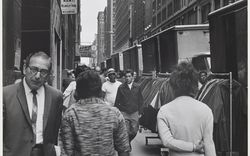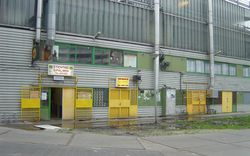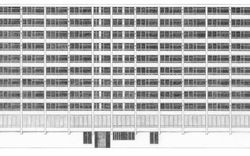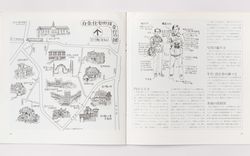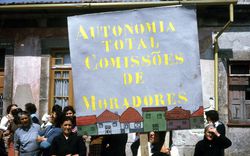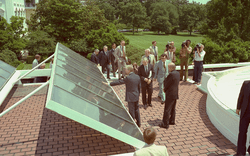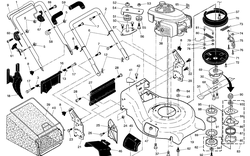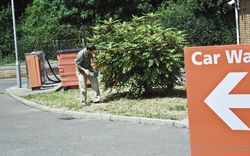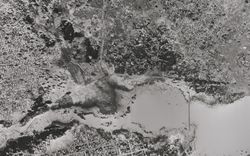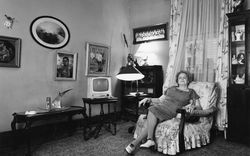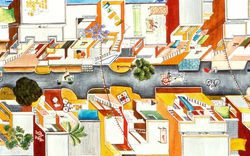9 of 99 Actions
Focus your attention on the city. Take a close look at things you think you’re already familiar with. All of us can define new ways of thinking “urban.”
Action 38: Foamy velour suits challenge authority
Actors: Sarah Ross
Tools: Foam, velour fabric, scissors, sewing machine
Site: Los Angeles, USA, 2005
Description: Artist Sarah Ross’s Archisuit project is jogging suits matching four Los Angeles locations: a Hollywood public library, a Silver Lake fence, the Ronald Reagan State Building, and public benches downtown. The suits’ foam padding fills negative space in each structure and allows the wearer to fit comfortably into or onto urban elements.
Action 33: Sheep and lambs eat city parks
Actors: Department of Park Management, City of Turin; shepherd Federico Tombolato
Tools: 700 sheep, 17 lambs
Site: Meisino, Sangone and Maddalena parks, Turin, Italy, since 2007
Description: The City of Turin saved thirty thousand euros by using sheep to mow lawns at three parks. Cows were also used in 2007, but produced too much manure. Traffic is diverted for the herd of sheep to enter the city, and after the animals are rotated through fenced-off parks for two months, they return to the Alps for the summer.
Action 58: Outlaw gardeners beautify city, Richard Reynolds, London, United Kingdom, since 2004
Actors: Guerrillagardening.org (Richard Reynolds), 5,113 gardeners
Tools: seed packets, plant bulbs, garden fork, gloves, lamp
Site: London, United Kingdom, and internationally, since 2004
Description: Richard Reynolds’s one-man war against lousy landscaping in London helped resurrect an urban movement that last resurfaced in the 1970s. Now working around the world, his guerrilla gardeners descend on traffic islands, forgotten parks, public gardens, and roadway edges for nighttime planting raids, illictly transforming untended spaces into gardens.
Action 92: Truck tires relax pedestrians
Actors: Millegomme (Jan Körbes, Mantas Lesauskas, Denis Oudendijk)
Tools: Tires, drill, screws, pickup truck
Site: Durban, South Africa, 2008
Description: Thirty Lazy Chairs and fifteen Four Meal Drive picnic tables made out of defective tires were put in a public park by members of the Millegomme collective, allowing people to rest and set up a market. Twelve more Lazy Chairs were installed in bus shelters where the city of Durban had only supplied metal railings to lean on.
Action 52: Clever tent keeps campers in city
Actors: Michael Rakowitz, campers
Tools: Car cover/tent
Site: Vienna, Austria; Trento, Italy; and internationally; since 2004
Description: Car-shaped tents that restore parking spaces to pedestrians as street-side camping. Any model of car can be reproduced by artist Michael Rakowitz to blend in with a national style or current fashion. The Porsche tent was stolen, but others continue to be used.
Action 2: Mapping the incomplete creates housing
Actors: Coloco (Nicolas Bonnenfant, Miguel Georgieff, Pablo Georgieff), tenants
Tools: Abandoned building, construction knowledge
Site: Rio de Janeiro, Brazil, and internationally since 1999
Description: Coloco is a French collective interested in scouting and appropriating abandoned structures that they call squelettes, or “skeletons.” Construction on the Teto Benjamin Constant building in Rio de Janeiro began in 1956 and was abandoned in 1957. The buyers who remained completed their own apartments, added rooms and windows, and rented out spaces to raise funds. The building became a co-operative in 1981.
Action 16: Timing for the next trash dash
Actors: Basurama (Yago Bouzada Biurrun, Benjamin Castro Terán, Alberto Nanclares da Veiga, Juan López-Aranguren Blázquez, Rubén Lorenzo Montero, Manuel Polanco Pérez-Llantada, Pablo Rey Mázon, Miguel Rodríguez Cruz), city residents
Tools: Municipal website, car
Site: Mallorca, Spain, 2006; Madrid, Spain, 2007
Description: Most cities have scheduled days each month when large garbage, like furniture, is picked up in certain neighbourhoods. Basurama, a collective formed in 2002 at Madrid’s School of Architecture and interested in urban waste, helps residents looking for furniture or appliances to travel to the right neighborhood on the correct date and at the correct time. They call these trips safari basura, literally “safaris in the dustbins.”
Action 12: Executive dines in dumpster
Actors: Freegans
Tools: Gloves, bag
Site: New York, USA; internationally
Description: Food safety rules do not allow groceries to sell, or some cases even give away, products that are past their expiry date, and many more fruits and vegetables are thrown out for cosmetic reasons. Dumpster divers and freegans short-circuit this flow of waste by shopping from dumpsters and garbage bags.
Action 52: Fake horses plan real park
Actors: muf architecture/art (Liza Flor, Katherine Clarke, Melanie Dodd); children of Tilbury; Countryside Agency; Local Heritage Initiative
Tools: Cardboard horse heads, horses, blankets
Site: Tilbury, United Kingdom, 2003–2004
Description: Muf architecture/art was commissioned to design a community park for the Broadway Estate in the town of Tilbury. The design brief did not mention that ponies sometimes grazed on the site, so muf initiated a history research project with local children using costumes and bus shelter advertisements to refine their design proposal.
These actions, among others, were presented in Actions: What You Can Do with the City, an exhibition and publication that we produced in 2008.

